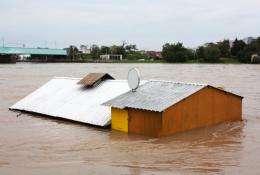Mastering the mysteries of the Madden-Julian Oscillation

Tropical monsoons, cyclones and thunderstorms. Weather patterns around the world are influenced by the MJO. And now, climate scientists can model it, thanks to research from Pacific Northwest National Laboratory and the National Center for Atmospheric Research. The Madden-Julian Oscillation, or MJO, is a 30-60 day atmospheric wave that affects weather from the Indian Ocean to the U.S. Pacific Coast. This study answers long-standing questions about where the MJO gets its energy and how its access to moisture affects the regularity and recurrence of the wave.
From monsoons in Mumbai, cyclones in Cairns, to floods and windstorms battering Seattle, the MJO leaves its mark on communities world-wide. Understanding the MJO and capturing its features in a climate model will help scientists better predict climate variations. In addition to questions about speed, scientists want to know why the MJO occurs on a cycle of 30-60 days. Current global climate models do not have a clear picture of the MJO, which hinders scientists' ability to predict its influence on rain, storms and weather systems that affect millions of people. This research provides answers to two compelling mysteries about the MJO.
Researchers Drs. Samson M. Hagos and L. Ruby Leung of PNNL, and Dr. Jimy Dudhia of the National Center for Atmospheric Research, looked at two major factors that propel and sustain the MJO: thermodynamics, or where it gets its heat and energy, and moisture. Their goal was to improve climate modeling of the MJO and authenticate results using observational data. They compared the empirical data to the model simulations of the MJO, where much of the MJO processes are currently represented with parameterizations, a way to express complex climate systems in a computationally efficient way. Their study looked at the moisture and the energy budget of the MJO to capture a more realistic picture of the atmospheric wave.
The researchers investigated the thermodynamic forces within this wave by performing an energy budget analysis on simulations of two MJO episodes observed during the winter of 2007-2008. Both model simulations were performed with and without constraining the model for cloud moistening, the process in which clouds collect water vapor from evaporation. With a moisture field constrained by observations, the researchers captured an accurate model depiction of the MJO. Without the moisture constraint, the model failed to correctly represent several characteristic features of the MJO. This finding enabled a complete thermodynamic budget analysis of the wave and identified the limitations of the model parameterization. Researchers also found that moisture and temperature in the MJO are strongly linked; the MJO instabilities are created by co-variation of moisture condensation with fluctuations in temperature.
PNNL scientists are using a regional model at a much finer scale than conventional climate models to understand the processes that determine the time-scales of MJO and the roles of various types of clouds in its energy cycle. They will identify possible sources limiting accurate depiction of the MJO in models that rely on cumulus cloud representations. These results will be published in a forthcoming edition of the Journal of Climate.
More information: Hagos S, LR Leung, and J Dudhia. 2011. "Thermodynamics of Madden-Julian Oscillation in a Regional Model with Constrained Moisture." Journal of Atmospheric Sciences, DOI: 10.1175/2011JAS3592.1
Provided by Pacific Northwest National Laboratory

















